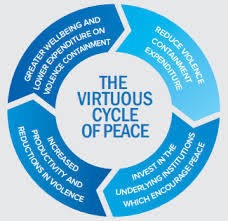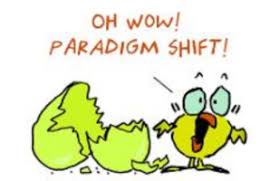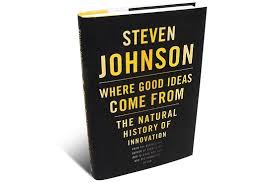
Virtuous Circles
This is the third of four blog posts on innovation. While innovation is important in its own right., I’m focusing on it now because I’m thinking of writing a book on a paradigm shift in American social and political life and am also using the series to focus my own thinking and define a research agenda—should I decide to do such a book.
My goal is to refine my own thinking and develop ideas for what peacebuilders and others can do in the coming weeks and months rather than what we could and should do right now. Others can do that far better than I can.

Schedule
June 5 Innovation for Social Change
June 12 Working From the Edge
June 19 Virtuous Circles
June 26 Innovating Yourself
In my five years as the Alliance for Peacebuilding’s Senior Fellow for Innovation, I’ve realized that there are two broad pathways toward game-changing shifts.
Last time, I looked at the “sexier” side of innovation, where cool new ideas disrupt business as usual because they are brought in from “beyond the edge” of a given field. Here, optimists tend to think of the smart phone while more skeptical observers focus on innovations that have had negative unintended consequences, including Uber or Facebook, just to cite two of the more obvious examples.
In this post I want to sketch out a second path that is probably more typical of most disruptive innovations and, more importantly, often comes without the risk of encountering negative side effects because of the way(s) they emerge. In particular, these are innovations that develop from the bottom up through four processes that I’ve also borrowed from other scholarly disciplines and applied to peacebuilding because they:
- create a virtuous circle of small changes that emerge after we
- identify bright spots or things that are already working because they
- take advantage of what environmental scientists call the adjacent possible
- can be taken to scale to produce sweeping changes in cultural and/or public policy that amount to a paradigm shift
(Mostly) Debunking a Myth
First, though, I have to dispel a myth, one I sort of bought into early in my days as a paradigm shift devoté.
I first read Thomas Kuhn’s Structure of Scientific Revolutions when I took a political science research methods course as a college sophomore in 1966. As both Kuhn and my instructor had hoped, it utterly changed the way I understood scientific progress because I now saw that the greatest steps forward came when we learned to view a subject with entirely new eyes. Not surprisingly, I also came to think of disruptive innovations largely as events that were akin to what Kuhn had in mind when he talked about paradigm shifts and scientific revolutions.
Perhaps because I read Kuhn’s book when I was nineteen, I did not take the revolutionary or struggling side of scientific revolutions or of any innovation seriously enough. I assumed that they emerged in one fell swoop like bird does from its shell as depicted in this cartoon.

In fact, very few paradigm shifts or lasting innovations are flashes that suddenly appear out of nowhere. As Kuhn reminded his readers time and time again, people come up with cool new ideas all the time. Only a handful of them become the kinds of disruptive innovations like the iPhone or Netflix that I wrote about last time.
More fail to take root for reasons that make perfect sense.
For example, a particular innovation may not be technologically possible. Thus, President Lincoln could not have realistically committing to sending people to the moon within a decade the way that President Kennedy did a century later. After all, humans hadn’t yet been able to invent any machines that could have gotten them even a few feet off of the planet’s surface.
Similarly, the relevant parts of the public just may not be ready for an innovation. In 2000, pets.com went public with a highly publicized IPO. Nine months later, it was gone. Now, two newer and quite profitable companies are fighting it out in a space that could not support a single online store twenty years ago.
In other words, innovations need more than great ideas to take root, take hold, and take off. In addition, they need four features I’ve focused on in analyzing the strengths of another kind of local peacebuilding, which is another kind of bottom up innovation.
Virtuous Circles
Most of us have spent a lot of time thinking about vicious cycles. We’ve all seen institutions as small as families or as big as countries get stuck in what feels like a never ending spiral of decay and deterioration that can last until the unit falls apart. That’s what a dysfunctional family or government can lead to.
Most of us spend less time thinking about what systems theorists call virtuous circles in which positive developments feed off of each other and strengthen the system as a whole. Indeed, systems theorists call these eufunctional or growing systems rather than the dysfunctional or deteriorating ones we spend so much time worrying about, especially after we watch the nightly news
The one depicted at the top of this post comes from the Institute for Economics and Peace’s research on positive peace. It suggest that greater well being tends to lead to a reduction in violence, an investment in key institutions, growing satisfaction with those institutions, which makes further improvements in these and other domains possible.
Bright Spots
 As with Kuhn’s paradigm shifts, virtuous circles like IEP’s rarely lead to system-wide change quickly, easily, or smoothly. However, social scientists and activists have developed a strategy that can take small or localized virtuous circles to scale.
As with Kuhn’s paradigm shifts, virtuous circles like IEP’s rarely lead to system-wide change quickly, easily, or smoothly. However, social scientists and activists have developed a strategy that can take small or localized virtuous circles to scale.
At first glance, it may seem counter intuitive.
We have an understandable tendency to want to convince our most adamant adversaries that we’re right. Failing that, we mount campaigns to get rid of them. In today’s situation, that leads to calls for disbanding or defunding the police and, of course, getting Donald Trump out of office.
I happen to agree with both of those goals.
However, my point here is that lasting and constructive change takes place when activists also follow another strategic pathway that lends itself to a longer term strategy through which we build on what start out as small and isolated virtuous circles.
As I have argued both in my books and in the previous set of four blog posts, what follows is a way towards turning the anger and frustration we are seeing on our streets into paradigm shift like changes at the national and even global levels.
That starts with an often-overlooked feature that you will find in the “origin story” of most successful social movements, They begin with outrage directed at, in today’s terms, brutal and racist police officers and the current administration. Given that outrage, it is not surprising that activists and analysts tend to overlook something else.
No matter how dire the overall situation might seem, you will invariably find places where things not only aren’t so bad but where people have actually found ways of at least partially overcoming the problem the problem that gave rise to the protests in the first place. In the case of police brutality toward people of color, observers now point to cities like Camden NJ or Flint MI where police departments have already endorsed sweeping changes.
You can find bright spots on almost any issue. My friends at CDA Collaborative wrote an entire book on communities that, in their words, opted out of war, which you can download for free by clicking the link that appears earlier in this sentence.
Statisticians refer to these kinds of cases as outliers. Public health experts call them positive deviants. Management gurus Chip and Dan Heath call them bright spots.
Whichever term you prefer, my political strategies always start there.
Dan Heath makes that point as clearly and as simply as possible.
Find the bright spots—what seems to work in your institution. Obsess about them. Study them and clone them.
Here, too, there are plenty of models to turn to for getting started. Appreciative Inquiry, for example, helps companies and other institutions identify core values that have led to past successes. The Omidyar Network has the people it works with focus on a long term goal (or guiding/north star) they want to reach, identify existing feedback loops that are already heading them in that directions, and then use those dynamics as leverage points for speeding up the pace of change.
Adjacent Possible
 The next piece of the strategy is anchored in evolutionary rather than political or social movement theory.
The next piece of the strategy is anchored in evolutionary rather than political or social movement theory.
It, too, is at least a bit counter intuitive,
Like most people, my first, gut instinct is to try to convince (or, worse) get rid of the people I disagree with.
That’s not likely to get me very far. And, it is not the best way to expand virtuous circles.
From that perspective, it makes sense to focus on what the evolutionary scientist Stuart Kauffman calls the adjacent possible. Species rarely evolve by making quantum leaps in their structure or capabilities—by, say, growing a second head or a third arm. Stephen Johnson then took the idea and applied it to innovative ideas more broadly in Where Good Ideas Come From
The adjacent possible is a kind of shadow future, hovering on the edges of the present state of things, a map of all the ways in which the present can reinvent itself.
Adj poss images
The key is Johnson’s last few word—the ways in which the present can reinvent itself.
Or as the data scientist, Gabriel Krieshok, puts it in the image here, the adjacent possible combines the limits imposed by the current  situation and the creative possibilities it still leaves open.
situation and the creative possibilities it still leaves open.
As the two of them see it, terrific new ideas get created and adopted in small steps that happen when people reach out to others they are most likely to convince. When they tinker with ideas until they make more and more sense. After they fail and learn the lessons from their mistakes.
In turn, that suggests building movements by reaching out, first, to one’s likely allies. To borrow a term from President George W. Bush which he used in a totally different way, you can go a lot way by building a “coalition of the willing.” Start by reaching out and activating the people who are closest to you—not those who are among your most diehard opponents.
I see that happening both in my own peacebuilding field through the +Peace campaign and in the remarkable Imperative 21 which is building coalitions around the need to reverse climate by restricting the economy in more sustainable ways.
Cumulative Strategies
 That, in turn leads to what I call a cumulative strategy.
That, in turn leads to what I call a cumulative strategy.
As far as I know, that term was first used by J.C. Wylie, who was an admiral and a military strategist and, thus, not part of the peacebuilding community. Nonetheless, he helped students at the Naval War College see that modern wars are never won because their leaders lay out a strategy before the first guns are fired and steadfastly follow it from then on until victory is won.
The world was already too complicated when he wrote and taught two generations ago.
Military leaders had to adapt their strategies in the light of what happened on the ground, on the sea, and in the air. They had to have a clear goal in mind, but they had to adapt their strategies as circumstances warranted. In Stephen Johnson’s terms, they had to build on the adjacent possible, constantly tinker with and fine tune their strategies, learn from their inevitable mistakes. Like a sailer heading into the wind, they had to keep their destination in mind but keep tacking and changing their heading if they wanted to reach their goal.
The same holds for a social movement trying to build itself in what Wylie’s colleagues at the Army War College called a VUCA world—volatile, uncertain, complex, and ambiguous. We have a pretty good idea of where we want to end up—a peaceful world that works for everyone. Just as it is for a military leader forced to deal with the Taliban or ISIS, it is absurd to assume that we know how to get “there.”
Instead, we have to follow a cumulative strategy.
Keep the long term goal(s) firmly in mind.
Of course.
But adapt your strategy.
As circumstances on the ground change.
As you add new and unexpected allies to your coalition.
As you learn from your successes as well as your mistakes.
Next Time
There is still one missing piece to this four-part puzzle to go along with all of the missing details in what I’ve written so far.
I’ve pretty much ignored what I’m convinced is the most important part of any innovative social innovation—the ways in which we have to change.
Stay tuned and come back next week to see how and why I reach this conclusion.
The views and opinions expressed in this article are those of the author and do not necessarily reflect the official policy or position of the Alliance for Peacebuilding or its members.
Also published on Medium.
